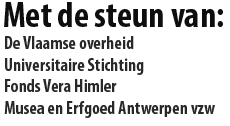H. BOONE
De Polka
Summary : The Polka
In this contribution Hubert Boone especially emphasizes the cultural- historical and the musical-technical aspects of the polka, a dance enthusiastically welcomed in Western Europe in the middle of the 19the century. The author discusses the origin of the polka and holds Rudolf Voss’s view in that the polka was not a new dance at all, but was linked with types of dance known in Germany years before. Hubert Boone also pays attention to the spread of the dance and the polka rage. Moreover, he has an eye for variants and adds colour to this article by means of musical notations. He obviously deals with the characteristics of Flemish polkas. This article also contains a comprehensive bibliography on the polka.
,
H. GEYBELS
Acculturatie tussen continuïteit en discontinuïteit in de rituele praxis van het vroege Westerse Christendom
Summary : Acculturation between continuance and discontinuance in the ritual practice of early Western Christianity
H. Geybels asks himself questions about the acculturation process that took place in the early Middle-Ages. At first he took it for granted that the Christian saints had taken over all the tasks and symbols from the gods and goddesses of the Germanic and Celtic nature religions. With the case of Saint Gertrude as basis, he examines the prevailing views in the relevant literature. These can be subdivided into two groups : the one that adheres to the continuance (Mathieis, Valgaerts, Schuyf, Mole Carpenter, etc.) and a much smaller group that favours the discontinuance (Delehay and Hartinger). Convincingly, Geybels joins with the latter group and criticizes the (pseudo)-scientific studies that assume a kind of continuance too easily.
,
K. VAN EFFELTERRE
Alternatieve geneeswijzen in opmars
Summary : Alternative therapy is on the up and up !
Recent reports showed that alternative medicine has been attracting considerable Attention from consumers and medical professionals in the last few decades.
In the past this international and even intercontinental phenomenon has already been the subject of numerous sociological and medical studies. The appeal of alternative medicine appears to be manifold, especially in a time when the omnipotence of conventional medicine is being questioned and the side-effects of some types of chemical medication have come to light. Since the demand of alternative medicine is expected to keep growing, the Belgian government decided to recognise four types of complementary medicine, namely homeopathy, chiropractic, acupuncture and osteopathy. The unanimous approval of this bill, together with the initiative of Belgian health insurance companies to partially cover the cost of recognised remedies met with a lot of negative criticism from doctors and pharmaceutical industrials. While the medical world reacts with great scepticism, physicians of complementary medicine are determined to win patients’ trust and to prove the effectiveness of their therapies.
,

